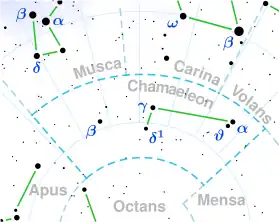HD 72922
HD 72922, also known as HR 3393, is a suspected astrometric binary[11] located in the southern circumpolar constellation Chamaeleon. A 1993 paper by Olin J. Eggen lists it as a member of the Milky Way's old disk population.[12]
 | |
| Observation data Epoch J2000 Equinox J2000 | |
|---|---|
| Constellation | Chamaeleon |
| Right ascension | 08h 24m 19.8867s[1] |
| Declination | −80° 54′ 51.2175″[1] |
| Apparent magnitude (V) | 5.67[2] |
| Characteristics | |
| Evolutionary stage | horizontal branch[3] |
| Spectral type | G8 III[4] |
| U−B color index | +0.74[5] |
| B−V color index | +1.02[5] |
| Astrometry | |
| Radial velocity (Rv) | 27.5±0.6[6] km/s |
| Proper motion (μ) | RA: −149.123[1] mas/yr Dec.: +226.547[1] mas/yr |
| Parallax (π) | 11.8882 ± 0.111 mas[1] |
| Distance | 274 ± 3 ly (84.1 ± 0.8 pc) |
| Absolute magnitude (MV) | +1.27[2] |
| Details[7] | |
| Mass | 0.96±0.04 M☉ |
| Radius | 9.65±0.17 R☉ |
| Luminosity | 41.2±0.9 L☉ |
| Surface gravity (log g) | 2.56±0.12 cgs |
| Temperature | 4,708±34 K |
| Metallicity [Fe/H] | −0.43±0.03 dex |
| Rotational velocity (v sin i) | <1[8] km/s |
| Other designations | |
| Database references | |
| SIMBAD | data |
It has an apparent magnitude of 5.67,[2] making it faintly visible to the naked eye under ideal conditions. Based on parallax measurements from the Gaia satellite, the system is estimated to be 274 light years away from the Solar System.[1] However, it is receding with a heliocentric radial velocity of 27.5 km/s.[6] At its current distance, HD 72922's brightness is diminished by magnitudes due to interstellar dust. It has an absolute magnitude of +1.27.[2]
The visible component is an evolved red giant with a stellar classification of G8 III. It is currently on the horizontal branch,[3] fusing helium at its core. It has 96% the mass of the Sun and an enlarged radius of 9.65 R☉.[7] It radiates 41.2 times the luminosity of the Sun from its photosphere at an effective temperature of 4,708 K, giving it a yellowish hue.[7] HD 72922 is metal poor with a metallicity only 37% that of the Sun;[7] it spins too slowly to be measured.[8]
References
- Brown, A. G. A.; et al. (Gaia collaboration) (2021). "Gaia Early Data Release 3: Summary of the contents and survey properties". Astronomy & Astrophysics. 649: A1. arXiv:2012.01533. Bibcode:2021A&A...649A...1G. doi:10.1051/0004-6361/202039657. S2CID 227254300. (Erratum: doi:10.1051/0004-6361/202039657e). Gaia EDR3 record for this source at VizieR.
- Anderson, E.; Francis, Ch. (May 2012). "XHIP: An extended hipparcos compilation". Astronomy Letters. 38 (5): 331–346. arXiv:1108.4971. Bibcode:2012AstL...38..331A. doi:10.1134/S1063773712050015. ISSN 1063-7737. S2CID 119257644.
- Laney, C. D.; Joner, M. D.; Pietrzyński, G. (11 November 2011). "A new Large Magellanic Cloud K-band distance from precision measurements of nearby red clump stars". Monthly Notices of the Royal Astronomical Society. 419 (2): 1637–1641. arXiv:1109.4800. Bibcode:2012MNRAS.419.1637L. doi:10.1111/j.1365-2966.2011.19826.x. ISSN 0035-8711. S2CID 250611916.
- Houk, N.; Cowley, A. P. (1975). University of Michigan Catalogue of two-dimensional spectral types for the HD stars. Volume I. Declinations −90° to −53°. Bibcode:1975mcts.book.....H. S2CID 208865539.
- Johnson, H. L.; Mitchell, R. I.; Iriarte, B.; Wisniewski, W. Z. (1966). "UBVRIJKL Photometry of the Bright Stars". Communications of the Lunar and Planetary Laboratory. 4: 99–110. Bibcode:1966CoLPL...4...99J. S2CID 117083574.
- Gontcharov, G. A. (November 2006). "Pulkovo Compilation of Radial Velocities for 35 495 Hipparcos stars in a common system". Astronomy Letters. 32 (11): 759–771. arXiv:1606.08053. Bibcode:2006AstL...32..759G. doi:10.1134/S1063773706110065. eISSN 1562-6873. ISSN 1063-7737. S2CID 119231169.
- Ottoni, G.; Udry, S.; Ségransan, D.; Buldgen, G.; Lovis, C.; Eggenberger, P.; Pezzotti, C.; Adibekyan, V.; Marmier, M.; Mayor, M.; Santos, N. C.; Sousa, S. G.; Lagarde, N.; Charbonnel, C. (January 2022). "CORALIE radial-velocity search for companions around evolved stars (CASCADES): I. Sample definition and first results: Three new planets orbiting giant stars". Astronomy & Astrophysics. 657: A87. arXiv:2201.01528. Bibcode:2022A&A...657A..87O. doi:10.1051/0004-6361/202040078. eISSN 1432-0746. ISSN 0004-6361.
- De Medeiros, J. R.; Alves, S.; Udry, S.; Andersen, J.; Nordström, B.; Mayor, M. (January 2014). "A catalog of rotational and radial velocities for evolved stars". Astronomy & Astrophysics. 561: A126. arXiv:1312.3474. Bibcode:2014A&A...561A.126D. doi:10.1051/0004-6361/201220762. eISSN 1432-0746. ISSN 0004-6361.
- Gould, Benjamin Apthorp (1878). "Uranometria Argentina : brillantez y posicion de las estrellas fijas, hasta la septima magnitud, comprendidas dentro de cien grados del polo austral : con atlas". Resultados del Observatorio Nacional Argentino. 1. Bibcode:1879RNAO....1.....G.
- "HD 72922". SIMBAD. Centre de données astronomiques de Strasbourg. Retrieved December 9, 2022.
- Eggleton, P. P.; Tokovinin, A. A. (11 September 2008). "A catalogue of multiplicity among bright stellar systems". Monthly Notices of the Royal Astronomical Society. 389 (2): 869–879. arXiv:0806.2878. Bibcode:2008MNRAS.389..869E. doi:10.1111/j.1365-2966.2008.13596.x. eISSN 1365-2966. ISSN 0035-8711. S2CID 14878976.
- Eggen, O. J. (July 1993). "Evolved GK stars near the sun. I - The old disk population". The Astronomical Journal. 106: 80. Bibcode:1993AJ....106...80E. doi:10.1086/116622.